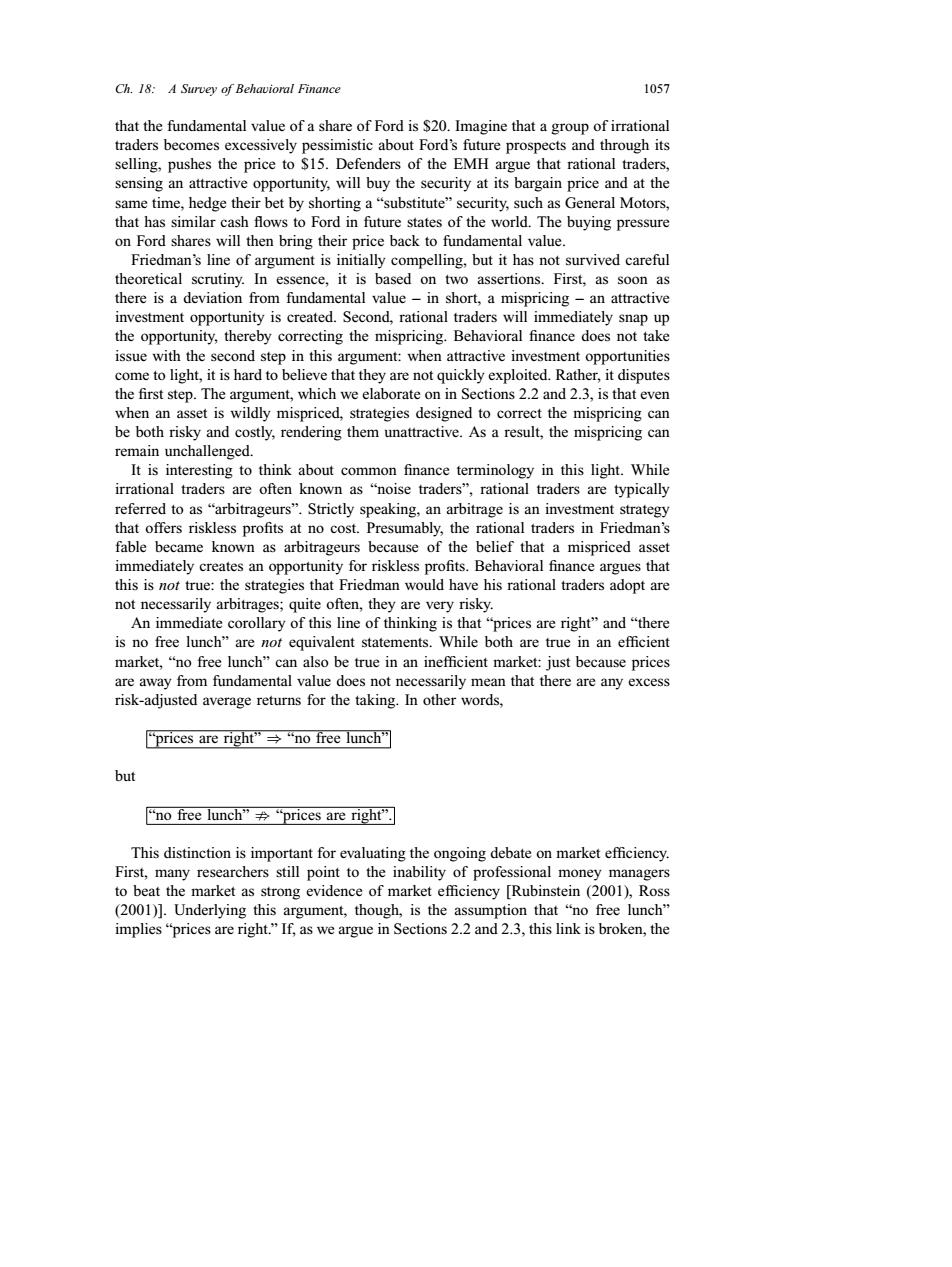正在加载图片...

Ch.18:A Survey of Behavioral Finance 1057 that the fundamental value of a share of Ford is $20.Imagine that a group of irrational traders becomes excessively pessimistic about Ford's future prospects and through its selling,pushes the price to $15.Defenders of the EMH argue that rational traders, sensing an attractive opportunity,will buy the security at its bargain price and at the same time,hedge their bet by shorting a"substitute"security,such as General Motors, that has similar cash flows to Ford in future states of the world.The buying pressure on Ford shares will then bring their price back to fundamental value. Friedman's line of argument is initially compelling,but it has not survived careful theoretical scrutiny.In essence,it is based on two assertions.First.as soon as there is a deviation from fundamental value-in short,a mispricing-an attractive investment opportunity is created.Second,rational traders will immediately snap up the opportunity,thereby correcting the mispricing.Behavioral finance does not take issue with the second step in this argument:when attractive investment opportunities come to light,it is hard to believe that they are not quickly exploited.Rather,it disputes the first step.The argument,which we elaborate on in Sections 2.2 and 2.3,is that even when an asset is wildly mispriced,strategies designed to correct the mispricing can be both risky and costly,rendering them unattractive.As a result,the mispricing can remain unchallenged. It is interesting to think about common finance terminology in this light.While irrational traders are often known as "noise traders",rational traders are typically referred to as"arbitrageurs".Strictly speaking,an arbitrage is an investment strategy that offers riskless profits at no cost.Presumably,the rational traders in Friedman's fable became known as arbitrageurs because of the belief that a mispriced asset immediately creates an opportunity for riskless profits.Behavioral finance argues that this is not true:the strategies that Friedman would have his rational traders adopt are not necessarily arbitrages;quite often,they are very risky. An immediate corollary of this line of thinking is that"prices are right"and"there is no free lunch"are not equivalent statements.While both are true in an efficient market,"no free lunch"can also be true in an inefficient market:just because prices are away from fundamental value does not necessarily mean that there are any excess risk-adjusted average returns for the taking.In other words, prices are right'”→"no free lunch" but no free lunch”“prices are right". This distinction is important for evaluating the ongoing debate on market efficiency. First,many researchers still point to the inability of professional money managers to beat the market as strong evidence of market efficiency [Rubinstein(2001),Ross (2001)].Underlying this argument,though,is the assumption that "no free lunch" implies"prices are right."If,as we argue in Sections 2.2 and 2.3,this link is broken,theCh. 18: A Survey of Behavioral Finance 1057 that the fundamental value of a share of Ford is $20. Imagine that a group of irrational traders becomes excessively pessimistic about Ford’s future prospects and through its selling, pushes the price to $15. Defenders of the EMH argue that rational traders, sensing an attractive opportunity, will buy the security at its bargain price and at the same time, hedge their bet by shorting a “substitute” security, such as General Motors, that has similar cash flows to Ford in future states of the world. The buying pressure on Ford shares will then bring their price back to fundamental value. Friedman’s line of argument is initially compelling, but it has not survived careful theoretical scrutiny. In essence, it is based on two assertions. First, as soon as there is a deviation from fundamental value – in short, a mispricing – an attractive investment opportunity is created. Second, rational traders will immediately snap up the opportunity, thereby correcting the mispricing. Behavioral finance does not take issue with the second step in this argument: when attractive investment opportunities come to light, it is hard to believe that they are not quickly exploited. Rather, it disputes the first step. The argument, which we elaborate on in Sections 2.2 and 2.3, is that even when an asset is wildly mispriced, strategies designed to correct the mispricing can be both risky and costly, rendering them unattractive. As a result, the mispricing can remain unchallenged. It is interesting to think about common finance terminology in this light. While irrational traders are often known as “noise traders”, rational traders are typically referred to as “arbitrageurs”. Strictly speaking, an arbitrage is an investment strategy that offers riskless profits at no cost. Presumably, the rational traders in Friedman’s fable became known as arbitrageurs because of the belief that a mispriced asset immediately creates an opportunity for riskless profits. Behavioral finance argues that this is not true: the strategies that Friedman would have his rational traders adopt are not necessarily arbitrages; quite often, they are very risky. An immediate corollary of this line of thinking is that “prices are right” and “there is no free lunch” are not equivalent statements. While both are true in an efficient market, “no free lunch” can also be true in an inefficient market: just because prices are away from fundamental value does not necessarily mean that there are any excess risk-adjusted average returns for the taking. In other words, “prices are right” ⇒ “no free lunch” but “no free lunch” “prices are right”. This distinction is important for evaluating the ongoing debate on market efficiency. First, many researchers still point to the inability of professional money managers to beat the market as strong evidence of market efficiency [Rubinstein (2001), Ross (2001)]. Underlying this argument, though, is the assumption that “no free lunch” implies “prices are right.” If, as we argue in Sections 2.2 and 2.3, this link is broken, the